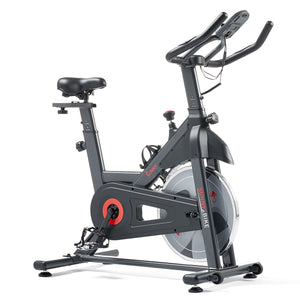If you’ve hit the gym recently or frequent in-person fitness classes, you’ve probably heard someone talking (or, more likely, bragging) about their fasted cardio routine.
Fasted cardio fanatics claim the practice can boost your fat-burning potential. So, what is fasted cardio, and does it even work? Here’s the scoop.
What Is Fasted Cardio?
At the most basic level, fasted cardio involves working out on an empty stomach. But it’s a little more complicated than that.
To qualify as fasted cardio, your body must be in a fasted state. Usually, that means eating no less than four to eight hours before your workout. However, it depends on how much food you ate at your last meal and how quickly it digests.
Regardless, the goal: your body is done processing and breaking down food, your insulin levels are low, and there’s no glucose in your blood (because it’s been used or stored by your body as glycogen).
The thought is, when glucose isn’t readily available, your body has to turn to another source of energy—ideally fat—to power your workout.
How to Do Fasted Cardio
The easiest way to do fasted cardio is in the morning (after an overnight fast). But a fasted state can also be achieved later in the day if you’re intermittent fasting or skip lunch before an early evening workout.
Plan to workout no more than 30 to 45 minutes, at a low- to moderate-intensity. In this heart rate zone, you’ll burn fat for energy; whereas, during high-intensity workouts—like HIIT, sprints, circuit workouts, or heavy weights—your body needs to burn fuel faster and relies on glucose as a preferred source of quick energy.
Benefits of Fasted Cardio
Although research is mixed, there are a few reasons you might want to give fasted cardio a shot. Here's a few.
Might Burn More Fat
You might be able to burn fat as fuel more readily when you have low glycogen levels (1)—which some research has suggested may contribute to weight loss (2).
A review of recent research found that, in several studies, fasted exercise boosted metabolism post-workout (3). However, other studies suggest there’s no difference in body composition between those who fast before exercise or not (4, 5). Experts note more research is needed to know the full effects of fasted cardio.
Less Exercise Induced Nausea
If you’ve ever felt nauseous during a workout, you’re in good company.
One study found that up to 70 percent of athletes may experience symptoms of nausea and vomiting during exercise (6). Another concluded exercise-induced nausea might be worse when you eat before you workout (7).
If you struggle with feeling well during your sweat sesh, it might be worth experimenting with what you eat, when you eat, or if you eat before your workout.
Works With Intermittent Fasting
If you’re already intermittent fasting, it can be tough to squeeze in a workout in the morning before work, especially if you usually eat first. Fasted cardio presents a convenient solution to that exact problem (8).
Does Fasted Cardio Contribute to Weight Loss?
Yes, fasted cardio can contribute to weight loss. That’s because exercise in general can help you achieve a caloric deficit, at least when paired with a balanced diet (9).
However, whether it boosts weight loss efforts beyond regular exercise is a mixed bag. One study found in comparison to non-fasted steady-state cardio, fasted steady-state cardio resulted in no difference in weight loss or body composition (4).
However, some research is in support. A review concluded that “aerobic exercise performed in the fasted state induces higher fat oxidation than exercise performed in a fed state” (3).
It’s important to remember the most important factor for weight loss is achieving a caloric deficit. How often, when, and how your body responds to exercise is important, but what you do throughout the rest of the day matters, too (i.e. how you fuel, getting enough sleep, staying hydrated).
Risks/Downsides of Fasted Cardio
While there are some benefits to fasted cardio, there are risks, too.
Could hamper muscle gain
If there aren’t enough carbs in your system for energy, your body begins a process called gluconeogenesis, which converts protein into fuel (10). One study found that one hour of steady cardio in a fasted state resulted in twice the amount of protein breakdown in muscle tissue (11). Which means less protein available to maintain and build muscle.
Might hinder performance
If you’re crushing workouts on an empty stomach, expect to feel low energy. One study found fasting before exercise negatively impacts workout intensity and length (12). The take home: if you’re working out for performance, eat before your workout.
Might not be safe for certain medical conditions
Avoid fasted cardio if you have a medical condition that’s affected by low sugar or blood pressure, or if you’re pregnant. If you’re a beginner, try fueled workouts, and focus on how your body reacts to regular exercise first.
Is Fasted Cardio Safe?
In most cases, yes. If you’re generally healthy, 30 to 45 minutes of steady-state fasted cardio is safe. However, listen to your body, and stop if you feel lightheaded, dizzy, shaky, or like you might pass out. Pay attention to signs like low blood sugar and dehydration and stop your session early if you feel unwell.
If you’re in a fasted state, avoid high intensity exercise like HIIT, bootcamp classes, CrossFit, or lifting weights. At worst, you could end up getting injured; at best, you’re not maximizing the benefits of your workout.
Should You Try Fasted Cardio?
Maybe. It depends on your preference and goals. If you prefer how fasted cardio feels, and don’t have any health complications, it’s generally safe. However, if you’re working out for performance, or have health concerns, fuel before your workout.
If you decide to fast, make sure to fuel right after your workout to give your body the energy it needs to recover. Try this tropical protein smoothie or this chocolate peanut butter protein shake.
1. Guillermo, E. et al (2020). Fasted Versus Nonfasted Aerobic Exercise on Body Composition: Considerations for Physique Athletes. https://journals.lww.com/nsca-scj/Abstract/2020/10000/Fasted_Versus_Nonfasted_Aerobic_Exercise_on_Body.8.aspx Accessed 5 February, 2023.
2. Batch, T. et al (2020). Advantages and Disadvantages of the Ketogenic Diet: A Review Article. https://www.ncbi.nlm.nih.gov/pmc/articles/PMC7480775/ Accessed 5 February, 2023.
3. Aird, R. et al (2018). Effects of fasted vs fed-state on performance and post-exercise metabolism: A systematic review and meta-analysis. https://onlinelibrary.wiley.com/doi/abs/10.1111/sms.13054 Accessed 5 February, 2023.
4. Shoenfeld, B. et al (2014). Body composition changes associated with fasted versus non-fasted aerobic exercise. https://www.ncbi.nlm.nih.gov/pmc/articles/PMC4242477/ Accessed 7 February, 2023.
5. Hackett, D. et al (2017). Effect of Overnight Fasted Exercise on Weight Loss and Body Composition: A Systematic Review and Meta-Analysis. https://www.mdpi.com/2411-5142/2/4/43 Accessed 7 February, 2023.
6. Samborski, P. et al (2013). Exercise-induced vomiting. https://www.ncbi.nlm.nih.gov/pmc/articles/PMC4027831/ Accessed 7 February, 2023.
7. Kondo, T. et al (2001). Exercise-induced nausea is exaggerated by eating. https://www.sciencedirect.com/science/article/abs/pii/S019566630090391X Accessed 7 February, 2023.
8. Welton, S. et al (2020). Intermittent fasting and weight loss. https://www.ncbi.nlm.nih.gov/pmc/articles/PMC7021351/ Accessed 10 February, 2023.
9. Cox, C. et al (2017). Role of Physical Activity for Weight Loss and Weight Maintenance. https://www.ncbi.nlm.nih.gov/pmc/articles/PMC5556592/ Accessed 10 February, 2023.
10. Libre Texts Chemistry (2022). Gluconeogenesis https://chem.libretexts.org/Bookshelves/Biological_Chemistry/Supplemental_Modules_(Biological_Chemistry)/Metabolism/Anabolism/Gluconeogenesis Accessed 10 February, 2023.
11. Schoenfeld, B. et al (2011). Does Cardio After an Overnight Fast Maximize Fat Loss? https://journals.lww.com/nsca-scj/Fulltext/2011/02000/Does_Cardio_After_an_Overnight_Fast_Maximize_Fat.3.aspx Accessed 12 February, 2023.
12. Terada, T. et al (2018). Overnight fasting compromises exercise intensity and volume during training but improves high-intensity aerobic endurance. https://www.minervamedica.it/en/journals/sports-med-physical-fitness/article.php?cod=R40Y2019N03A0357 Accessed 12 February, 2023.


























Add Your Name & Email
Please enter your name and email to continue.We won’t display your email publicly.